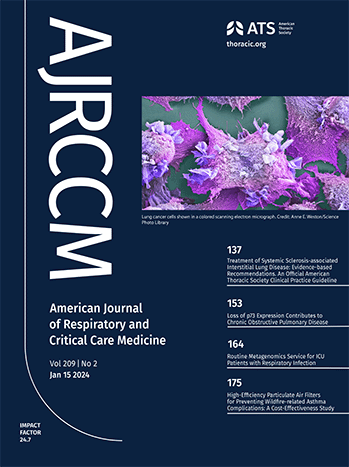慢性阻塞性肺病表型的时间探索:从 COPDGene 和 SPIROMICS 群体中获得的启示。
IF 19.3
1区 医学
Q1 CRITICAL CARE MEDICINE
American journal of respiratory and critical care medicine
Pub Date : 2024-09-13
DOI:10.1164/rccm.202401-0127oc
引用次数: 0
摘要
背景慢性阻塞性肺病(COPD)的进展具有相当大的异质性。我们假设弹性主图分析(EPGA)能识别不同的临床表型及其纵向关系。方法使用 8972 名烟草暴露的 COPDGene 参与者的横断面数据(有 COPD 和无 COPD),利用 30 个临床、生理和 CT 特征来训练 EPGA 模型。采用主成分分析 (PCA) 将数据维度降低到六个主成分。弹性主树被拟合到缩小的空间中。COPDGene 第二阶段的 4585 名参与者被用来测试纵向轨迹。我们的分析使用横截面数据创建了一棵弹性主树,树上的距离代表时间概念。根据肺功能、症状和 CT 特征的不同,确定了六个临床上不同的树段:1)亚临床(SC);2)实质异常(PA);3)慢性支气管炎(CB);4)男性肺气肿(EM);5)女性肺气肿(EF);6)严重气道(SA)疾病。SPIROMICS 横截面数据证实了类似的分组。来自 COPDGene 的 5 年数据将纵向变化映射到该树上。29% 的患者在随访期间改变了分段;纵向轨迹证实了患者沿着该树从 SC 向肺气肿的净流动,尽管也注意到了通过气道疾病主要表型、CB 和 SA 的其他轨迹。这些见解与临床相关,有助于精准治疗和未来改变疾病进展的试验。本文章由计算机程序翻译,如有差异,请以英文原文为准。
Temporal Exploration of COPD Phenotypes: Insights from the COPDGene and SPIROMICS Cohorts.
BACKGROUND
Chronic obstructive pulmonary disease (COPD) exhibits considerable progression heterogeneity. We hypothesized that elastic principal graph analysis (EPGA) would identify distinct clinical phenotypes and their longitudinal relationships.
METHODS
Cross-sectional data from 8,972 tobacco-exposed COPDGene participants, with and without COPD, were used to train a model with EPGA, using thirty clinical, physiologic and CT features. Principal component analysis (PCA) was used to reduce data dimensionality to six principal components. An elastic principal tree was fitted to the reduced space. 4,585 participants from COPDGene Phase 2 were used to test longitudinal trajectories. 2,652 participants from SPIROMICS tested external reproducibility.
RESULTS
Our analysis used cross-sectional data to create an elastic principal tree, where the concept of time is represented by distance on the tree. Six clinically distinct tree segments were identified that differed by lung function, symptoms, and CT features: 1) Subclinical (SC); 2) Parenchymal Abnormality (PA); 3) Chronic Bronchitis (CB); 4) Emphysema Male (EM); 5) Emphysema Female (EF); and 6) Severe Airways (SA) disease. Cross-sectional SPIROMICS data confirmed similar groupings. 5-year data from COPDGene mapped longitudinal changes onto the tree. 29% of patients changed segment during follow-up; longitudinal trajectories confirmed a net flow of patients along the tree, from SC towards Emphysema, although alternative trajectories were noted, through airway disease predominant phenotypes, CB and SA.
CONCLUSION
This novel analytic methodology provides an approach to defining longitudinal phenotypic trajectories using cross sectional data. These insights are clinically relevant and could facilitate precision therapy and future trials to modify disease progression.
求助全文
通过发布文献求助,成功后即可免费获取论文全文。
去求助
来源期刊
CiteScore
27.30
自引率
4.50%
发文量
1313
审稿时长
3-6 weeks
期刊介绍:
The American Journal of Respiratory and Critical Care Medicine focuses on human biology and disease, as well as animal studies that contribute to the understanding of pathophysiology and treatment of diseases that affect the respiratory system and critically ill patients. Papers that are solely or predominantly based in cell and molecular biology are published in the companion journal, the American Journal of Respiratory Cell and Molecular Biology. The Journal also seeks to publish clinical trials and outstanding review articles on areas of interest in several forms. The State-of-the-Art review is a treatise usually covering a broad field that brings bench research to the bedside. Shorter reviews are published as Critical Care Perspectives or Pulmonary Perspectives. These are generally focused on a more limited area and advance a concerted opinion about care for a specific process. Concise Clinical Reviews provide an evidence-based synthesis of the literature pertaining to topics of fundamental importance to the practice of pulmonary, critical care, and sleep medicine. Images providing advances or unusual contributions to the field are published as Images in Pulmonary, Critical Care, Sleep Medicine and the Sciences.
A recent trend and future direction of the Journal has been to include debates of a topical nature on issues of importance in pulmonary and critical care medicine and to the membership of the American Thoracic Society. Other recent changes have included encompassing works from the field of critical care medicine and the extension of the editorial governing of journal policy to colleagues outside of the United States of America. The focus and direction of the Journal is to establish an international forum for state-of-the-art respiratory and critical care medicine.

 求助内容:
求助内容: 应助结果提醒方式:
应助结果提醒方式:


